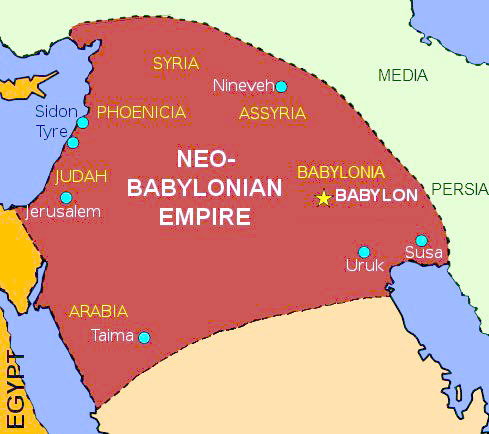Although weakened by Kassites invasion, Babylon was still an important economic center of Mesopotamia. Neo-Babylonian Empire belongs to the countries of the I Millennium BC, whose main characteristic is that it lasted for a very short time. Neo – Babylonian Empire lasted less than a hundred years (616 – 539 BC). The term Babylon has more meanings. Large architectural activity made that, Babylon in the period of VI – IV century became a great metropolis. It was the economic center, but it was never the capital. Several Old Testimony stories are linked to the city. One of those story is ‘’A story about Babylonian Tower’’. One of the Seven Wonders of the World were located in Babylon, those were hanging gardens of Queen Semiramis.



Although, there is belief that Herodotus description of the city was invented, however archaeological excavations confirmed it to some extent. Babylon is also one of the symbols of Utopia – ideal for life, which up until today is current issue for various works. At the end of II Millennium BC, in the southern part of Mesopotamia appeared Semitic tribe of Chaldeans, which won the Southern Babylon. They led a relentless struggle with Assyria. After the death of the Emperor of Assyria Ashurabanipal, Babylon was released from Assyrian power, and in alliance with the Medes, it gave to Assyria final blow. Assyrian ruler Ashurabanipal and the Crown Prince has died in 627 BC. Nabopalassar (626 – 605 BC) chief of Assyrian forces, took advantage of this situation and established authority over Babylon. Palace did not respond to this, because the royal family was engaged in a number of pretenders to the throne. He finally managed to establish control over Babylonia (626-615 BC). Sources say, the Babylonian chronicle, that around 616/5 BC Babylon was firmly in his hands.
In the period between 614 and 605 BC, Nabopolassar led war for Assyrian heritage. He made a pact with the ruler Medes Cyaxares. The Union has been secured by dynastic marriage. The daughter of Cyaxares became the wife of Nebuchadnezzar II, Nabopolassar’s son. In 614 BC, there was a battle for Ashur, and after that came the attack on Nineveh in 612 BC, when the Nineveh was completely destroyed. The Assyrians then retreated to northern Syria. At that place, there was a battle of Haran in 610 BC. The Assyrians were defeated. The final point of the clash was Carchemich in 605 BC. The Egyptians and the rest of the Assyrian army clashed with Nabopolassar and Cyaxares. Babylonians came out as winners. Nabopolassar then retreated to Babylon, and he died suddenly the same year.
Nebuchadnezzar II hurried back to Babylon to take the crown, which gave to the Egyptians an opportunity to prosper in the Levant. Pharaoh Necho II (Nekau) wanted to bring ruler of Judah, Josiah at his side, but he refused. After the battle that took place in 609 BC, Josiah was killed.



The goal of Nebuchadnezzar II (604-562 BC) was to regain cities in the Levant. In 601 BC, he besieged Jerusalem.
Then he went to Egypt with a desire to punish Pharaoh Necho II. They clashed near Migdol. The battle ended untied, and they made some sort of separate peace. Judah refused to pay tax to Nebuchadnezzar II, which led to the war. Nebuchadnezzar went to Judea and he besieged Jerusalem. The city rebelled once again and Nebuchadnezzar besieged the city for a second time in 598 BC. There was another siege, in 586 BC, when the city was conquered and partially destroyed. On that occasion, Solomon’s Temple was destroyed, and the Ark of the Covenant was lost. The population was deported, mainly in the area near Babylon – “Babylonian slavery”. Babylonian slavery lasted until 538 BC, when the Persian emperor Cyrus II conquered Babylon. Cyrus II is the only foreigner who is mentioned in the Old Testament and he was called the Mesion. Persian ruler Cyrus the Great allowed the Jews to return to their homeland, and 40,000 of them took advantage of that opportunity. About this fact many biblical stories are talking about Ezra and Nehemiah. They were allowed to rebuild the temple, which was destroyed for the second time in the 70., at the time of ancient Rome. It was only preserved “Wailing Wall”, part of the walls from the Herod’s period. The place where the temple was located, has been a sacred place for all three monotheistic religions. Today, at that place there is “Dome on the rock”, which was built in the seventh century by Byzantine builders draft.
After the fall of Assyria, a territory was divided: Babylonia was given a central part of the former Assyria, while Medes was given its north – eastern part. In western Asia Minor, at that time Lydia raised. Medes and Lydia were in conflict (590 – 585 BC). Their last clash happened on 28 May 585 BC, when peace was made. Agreement on the division of the interest spheres was made between Alyattes (Croesus father) and Astyages, ruler of the Medes. The river Halys (Turkish Kızılırmak) was the border between the two countries. The battle was interrupted due to a solar eclipse, which was predicted by Thales of Miletus. That is why we know for sure the exact date, when this battle took place.
Nebuchadnezzar II died in 562 BC. He was succeeded on the throne by his own son Amel-Marduk (561-560 BC), which, however, ruled very briefly. His successor was Neriglissar (559-556 BC). About these two rulers, there is not a lot of information. After Neriglisar, on the throne came Nabonidus (556-539 BC), who probably was not a Chaldean origin. He was the last ruler of Neo – Babylonian Empire. When king Cyrus of Persia strengthened, he was ready to take Babylon around 539 BC. Nabonidus was defeated in Sippar, after that defeat Babylon surrendered without fighting to the Persian emperor.
